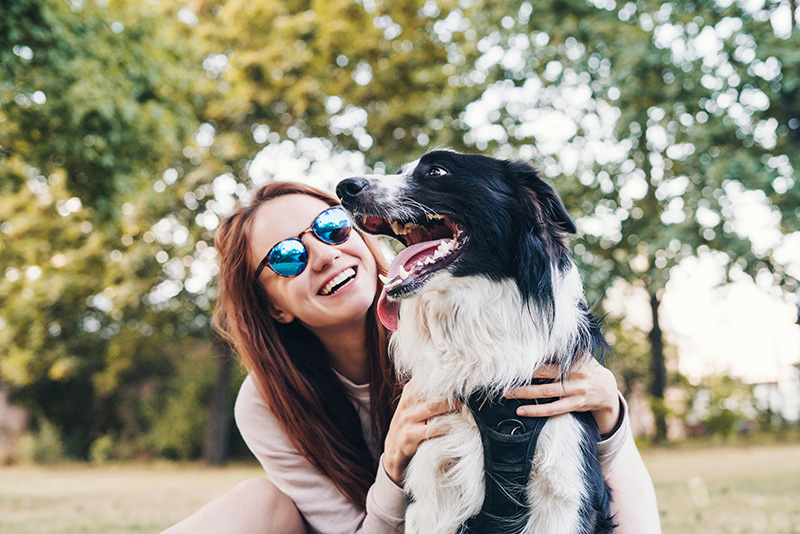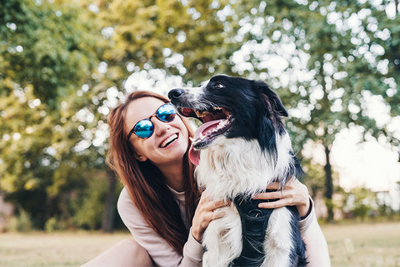Posted by K9 Active on Jul 21, 2023
Choosing the perfect dog harness for your furry friend can feel a bit like trying to find the coziest sweater in a department store full of options. But don't fret! We're here to guide you through the process, ensuring your dog's comfort, safety, and style are all ticked off the list.

Why Choose a Harness?
Think of a dog harness as a magic cape for your canine companion. Not only does it give you better control during walks, but it also ensures your dog's neck and back are protected, especially if they have a habit of pulling on their leash faster than a speeding bullet!
Types of Dog Harnesses
Just like superheroes have different superpowers, dog harnesses come in various types, each designed to cater to different needs and situations. Let's explore some of them:
Standard Harness
A standard harness is like your dog's everyday uniform. It's typically made of webbing material and distributes the force of the leash across your dog's chest. While it's a common choice, it might not be the best option for larger, more energetic dogs, or those who require additional comfort or support.
No-Pull Harness
No-pull harnesses are the superheroes of the dog harness world. These harnesses are designed with a front attachment point that, when your dog pulls, steers them towards you. This helps your dog understand that pulling isn't the most effective way to move forward. Our Ruffwear Front Range Harness is a popular no-pull harness that offers four points of adjustment for a perfect fit.
Step-In Harness
Step-in harnesses are easy to put on and offer more control over your dog. They are not recommended for strong pullers. The EzyDog Chest Plate Harness, coming soon to our store, is a great step-in harness that combines the control of a collar with the comfort of a harness.
Over-the-Head Harness
Over-the-head harnesses provide good control and are easy to put on. They are a popular choice for many dog owners. Check out the Rukka Solid Harness , the Hurtta Weekend Warrior Harness , and the Ruffwear Hi & Light Harness for some great over-the-head harness options.
Harness Shape: The Importance of a Y-Shaped Harness
When choosing a harness, consider its shape. We recommend a Y-shaped harness as these do not restrict your dog's leg or shoulder movement, unlike Norwegian-style harnesses or harnesses with a large strap that goes across the front of the chest. Imagine trying to run with your arms tied together - not very comfortable, right? The same goes for your dog. A Y-shaped harness ensures they can move freely and comfortably on all their adventures.
Choosing the Right Size and Fit
Ensuring that your dog's harness fits correctly is essential for their comfort and safety. Each harness brand may have its own sizing guidelines, so it's crucial to follow the specific instructions for the harness you choose. Here's a step-by-step guide to help you measure and fit your dog's harness:
Measure Your Dog
Using a soft tape measure, measure around your dog's chest just behind their front legs. Take note of this measurement in inches or centimeters, depending on the manufacturer's sizing chart.
Refer to the Sizing Chart
Each harness brand will have a sizing chart that corresponds to the measurements you've taken. Compare your dog's measurements to the chart to find the right size. If your dog's measurements fall between two sizes, it's best to choose the larger size for a comfortable fit.
Adjust the Straps
Once you have the harness, place it on your dog and adjust the straps to achieve a snug but not tight fit. You should be able to fit two fingers between the harness and your dog's body. The chest strap should sit just behind the front legs, and the back strap should sit along the back without rubbing against the skin.
Check for Chafing
After fitting the harness, check for any signs of chafing or discomfort. Make sure there are no areas where the harness rubs against your dog's skin. If you notice any irritation, consider adjusting the fit or trying a different harness style.
Regularly Check the Fit
As your dog grows or gains/loses weight, it's essential to recheck the harness's fit regularly. A well-fitted harness ensures your dog's comfort and prevents any potential escape attempts.
Harnesses for Specific Activities
Some harnesses are designed for specific activities. Let's delve into some of these:
Running
If you love trail running with your dog, consider a running harness like the Ruffwear Flagline Harness. For the human part of the team, running belts such as the Trail Runner Belt or Rukka Running Belt can make the experience more comfortable and enjoyable.
Travel
If you frequently travel with your dog, a car safety harness like the EzyDog Drive Car Harness can keep your dog secure during road trips. Remember, it's the law that your dog must be suitably restrained so they cannot distract you while driving or injure either you or themselves.
Assistance
For elderly dogs or tri-paws (dogs that have had a leg amputation), an assistance harness can provide the support they need to move around comfortably and safely. These harnesses are designed to help lift and assist your dog when they have difficulty moving on their own. The Ruffwear Web Master Harness and the Ruffwear Doubleback Harness are excellent examples of assistance harnesses.
Introducing Your Dog to Wearing a Harness
Introducing a harness to your dog can be a positive and rewarding experience. Here are some techniques to help your furry friend get used to wearing a harness:
Positive Reinforcement
Use positive reinforcement techniques to create a positive association with the harness. Offer your dog treats, praise, or their favorite toy whenever you bring out the harness. Gradually introduce the harness and reward your dog for showing interest or approaching it willingly.
Take It Slow
Don't rush the process. Allow your dog to sniff and explore the harness at their own pace. Avoid forcing the harness onto your dog or making them wear it for extended periods initially.
Desensitization
Once your dog is comfortable with the harness's presence, gently touch and handle the harness while giving treats and praise. This helps desensitize your dog to the feeling of wearing the harness.
Practice Dress-Up
Before heading out for walks, practice putting the harness on your dog indoors for short periods. Again, reward them with treats and praise for wearing the harness calmly.
Short Walks
For the first few walks, keep them short and positive. Use treats and praise to encourage your dog to walk with the harness on. Gradually increase the duration of walks as your dog becomes more comfortable.
Remember, patience and positive reinforcement are key to successfully introducing your dog to wearing a harness. By making the experience enjoyable, your furry friend will associate the harness with pleasant activities and will be eager to wear it for all your adventures together!
Conclusion
Choosing the perfect dog harness involves understanding your dog's needs, behavior, and the activities you plan to do together. Remember, the best harness for your dog is one that they feel comfortable in and suits their lifestyle.
At K9 Active, we offer a wide range of dog harnesses suitable for all breeds, sizes, and activities. Explore our collection of dog harnesses and find the perfect one for your furry friend today!
